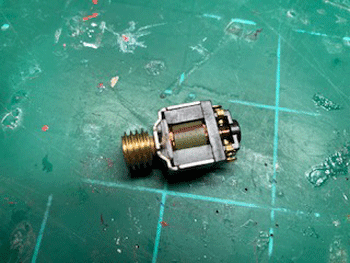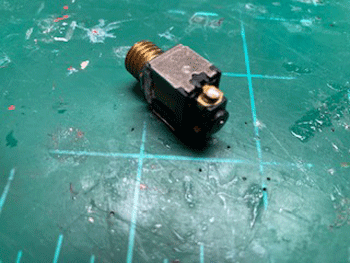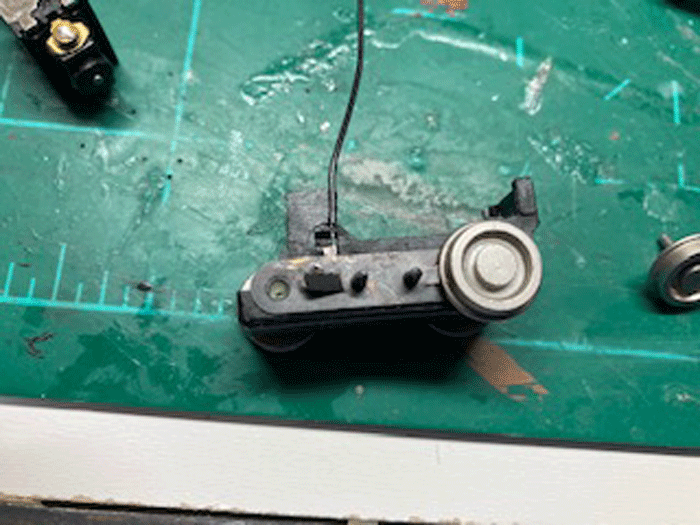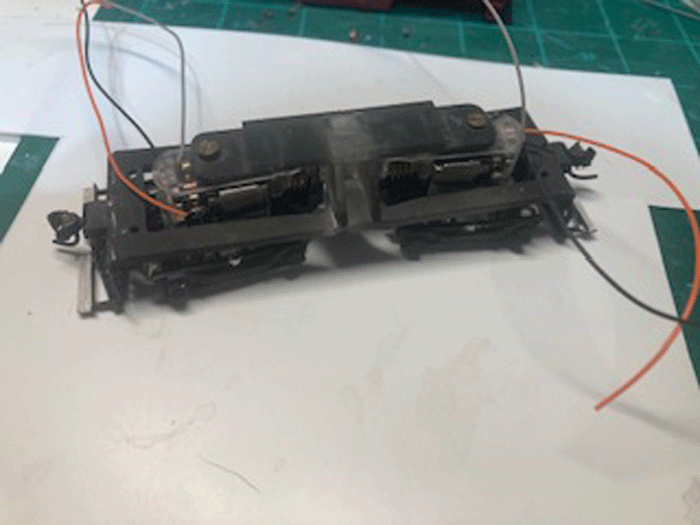The project I am sharing is neither complex nor difficult; the components are easily attainable and probably one of the least expensive traction exercises you will attempt, provided you can source the donor(s) Bachmann 44 Tonner Diesel loco at a reasonable cost on Ebay or other 2nd hand vendor. Patience pays off here, as many vendors are especially proud of their offerings and reflect this pride in the asking price. I usually aim for a $25.00 target, road name is of no consequence as you will paint it anyway. Make sure the handrails and side frames are intact. As you can see in photos 1 & 2 I have a little assembly line.
I will cover the creation of two distinctly different HO scale Pacific Electric locomotives; the first is a 44 Ton diesel (known as “Cooties”) that carried a trolley pole only to activate signals. You want the Bachmann Spectrum Series model in the gold and black box, which has two separate drive motors (see photos 3 & 4), two views of the same motor).
 |
 |
The later models, I understand, have only one motor (although I have never personally seen this version). This one is simple; you convert the loco to DCC and paint it to reflect either the red or black version; tack on a few detail parts, add a trolley pole and decals. Although the actual locomotive was diesel and did not rely on the pole for power mine off of the overhead full time. The source material for the 44 Tonner conversion to Pacific Electric is in the August 1990 issue of Railroad Model Craftsman and authored by Robert Smaus. No drastic body cutting; a small amount of scratch building for the roof platform and pole hold downs is required. The conversion to DCC, in particular the isolation of the two motors, is covered in the January 2001 issue of Model Railroader and is authored by Tony Capato. I have a couple of methods I use that simplify Mr Capato’s instructions that you may find useful; the first is that it is unnecessary to use a moto tool to cut the tabs when isolating the motor; these tabs are as thin as a sheet of paper and can be cut with scissors. Also, the wheels pop right off the power unit (see photo 5) (Photo 5 shows the Bachmann gearbox with one axle pulled to show the electrical pickup beneath the sideframe) making the cutting/soldering much easier.
 |
If DCC conversion is not desired, you need only make the truck motor conversion to run from overhead power. If you decide that in addition to DCC you want a working trolley pole, I have this information from an email I received from a fellow named Karl Peery in February 2012. Later attempts to contact him at the email address I had went unanswered, so I was pleased to find the instructions still in my trolley file eight years later. Copies of the actual email are available on request, just let me know.
The second project, a high quality generic electric Steeple Cab kit, was produced by the former Cannonball Car Shops and appears on Ebay regularly, at least until the stock inventory is exhausted. The former owner has since retired due to health issues but the kits are still available as of this writing. I painted mine black in an attempt to match the PE version, but my decals are incorrect but close enough, I say. This project is more involved; still simple, but more components and therefore more cash outlay. It uses the same drive mechanism as the aforementioned 44 Tonner, but since the Steeple Cab rides low, another kit is required to lower the height of the trucks. This lowering kit (see photo #6 below) is produced by American Model Builders, Inc (affiliated with Laser Kit), part number 9201, and it allows you to flip the Bachmann motors on their sides to lower them.
 |
This lowering kit is made of clear plastic and construction is pretty straight forward. If you opt to skip the lowering, the loco looks totally ridiculous. AMB also offers the additional goodies you will want to complete the model, such as correct side frames #9200, a rooftop trolley pole platform #9204, a jig to drill out your handrails, the handrail jig itself and pilots with foot boards #9205. These components will set you back around $60, on top of the cost of your donor 44 Tonner motors. Of course the trolley pole is additional, unless you are like me and have several lying around that you can scavenge.
Once the Steeple Cab kit is complete, you need only to convert your donor 44 Tonner motors to DCC and wire them to run on overhead power if desired. I enjoy these particular models because they handle tight curves easily due to their compact size and have a utilitarian “attitude”. As I stated earlier you will probably decide to scratch build your roof platforms unless you go with the style available in the kit, which are very nice but not appropriate for the roads I model.
Note: Nick is currently a member of the Southern California Traction Club